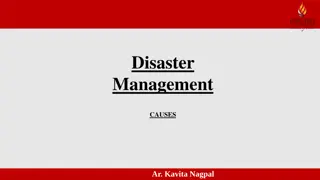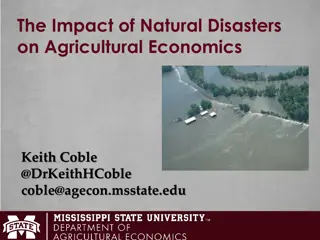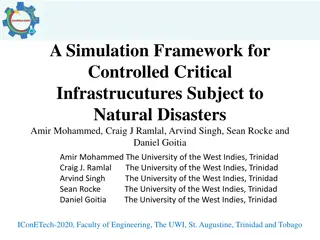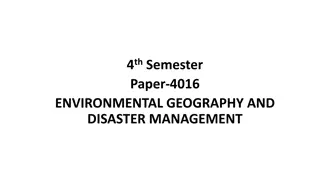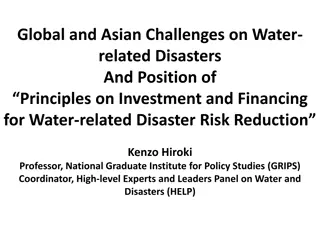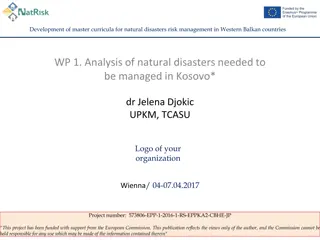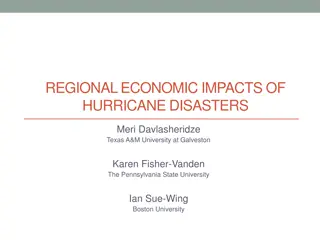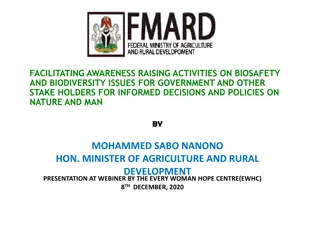Understanding the Economic Impact of Natural Disasters on Agriculture
Natural disasters in the United States have led to significant economic losses, with Florida alone experiencing billions in damages annually. The SERA Proposal focuses on assessing vulnerabilities, enhancing system resilience, and utilizing state-of-the-art tools for disaster impact assessment, especially in agriculture. The proposal aims to mitigate risks, manage economic development, and protect various agricultural assets at risk from disasters.
Download Presentation

Please find below an Image/Link to download the presentation.
The content on the website is provided AS IS for your information and personal use only. It may not be sold, licensed, or shared on other websites without obtaining consent from the author. Download presentation by click this link. If you encounter any issues during the download, it is possible that the publisher has removed the file from their server.
E N D
Presentation Transcript
SERA PROPOSAL ON NATURAL DISASTERS CHRISTA D. COURT, ASSISTANT PROFESSOR DIRECTOR, ECONOMIC IMPACT ANALYSIS PROGRAM FOOD AND RESOURCE ECONOMICS DEPARTMENT UNIVERSITY OF FLORIDA September 23, 2019
Natural Disasters in United States Since 1980, the United States has experienced 246 billion dollar natural disasters, resulting in a total cost of $1.6 trillion. Florida alone has experienced $5 10 billion in economic losses annually resulting from natural disasters Photo Sources: http://www.bocaratontribune.com/wp-content/uploads/2017/06/hurricane.jpg, http://jax-cdn.com/news/metro/public-safety/2017-04-03/florida-forest-service-offers-wildfire-prevention-tips, https://www.monroecountyem.com/index.aspx?NID=110, http://orlando-rising.com/orlando-central-florida-experiencing-worst-drought-in-a-century/, http://www.miamiherald.com/news/local/environment/article49331405.html,
Billion dollar disasters are increasing in number and cost. Doesn t necessarily indicate that disasters themselves are increasing in number or intensity
Southeast states appear on the higher end of frequency in every type of disaster monitored.
Pillars of the SERA Proposal 1. Assessment Vulnerabilities Losses Damages 2. System Resilience Risk Management Mitigation Economic Development
State of the Art Tools for Disaster Impact Assessment HAZUS Federal Emergency Management Agency, U.S. Department of Homeland Security REacct Sandia National Laboratory, U.S. Department of Energy E-CAT University of Southern California Little focus on estimating economic impacts specific to agriculture
Agricultural Assets at Risk Standing annual and perennial crops Live animals Forest inventory Nursery/greenhouse structures Irrigation systems Roads, ditches, stormwater impoundments Livestock and aquaculture facilities Farm machinery Farm homes and office buildings Packinghouses and processing facilities Research, extension, and teaching facilities
Impacts of Natural Disasters on Agriculture Losses vs. Damages
Types of Agricultural Losses from Natural Disasters Direct crop and animal losses resulting in decreased output and revenues Increased input costs (e.g. fertilizer, chemicals, feed, vet services) Preparation costs for a specific disaster
Types of Agricultural Damages from Natural Disasters Crop and animal damage Destroyed trees and other perennial plantings Deceased animals Infrastructure damage Irrigation systems Livestock shelters Aquaculture equipment and hatcheries Farm equipment and machinery Post-production facilities
Important Considerations for Measuring Impacts of Natural Disasters on Agriculture Agriculture is a seasonal activity Sectoral impacts can vary widely Short-term impacts vs. Medium and Long-term impacts
Additional Considerations Agricultural impacts of natural disasters can potentially cause Unemployment and/or a decline in wages among farmers and farm workers Rises in food imports and drops in food exports Potential long term loss of market share An increase in the level of food insecurity Damages and losses to the agriculture sector accumulate over time as a result of recurring natural disasters Constrains economic growth in the agricultural sector
Need for survey to assess agricultural losses and damages Timely provision of credible estimates is a key component of official disaster declaration and disaster relief and recovery Cooperative Extension is recognized as a reliable and unbiased source for this information Manner in which data on agricultural losses and damages are currently collected, analyzed, and published presents challenges for the multiple stakeholders involved in the process An online survey instrument was designed to harmonize the UF- IFAS Extension data collection process
Agricultural loss and damage survey Designed to collect information in a format that is compatible with the requirements of the USDA-Farm Service Agency STORM system (USDA, 2012) Replaced the Flash reports In the event of a natural disaster, an invitation to participate in the survey, along with a link to the survey, is emailed to UF-IFAS Extension agents in the affected areas Compatible with both desktop computers and mobile devices with either Android or iPhone operating systems. Completion considerations Public sector employees should complete the survey for each agricultural operation observed or farm owner/manager interviewed Respondents should complete the survey as many times as possible to get a representative sample of operations affected by the disaster in their county or multi-county area, subject to time constraints and safety concerns Knowledge and experience of the local Extension agent will determine the different types of agricultural commodities that should be surveyed in his/her area Voluntary, and there is no compensation provided
Agricultural Losses Requests name of the respondent and farm observed or farm owner interviewed County or counties in which the farm/business is located Type of disaster Hurricane/tropical storm, tornado, wind, excess rain, flood, drought, hail, freeze, excess heat, wildfire, or other extreme weather event Whether the record is a first-hand, in-person observation or second-hand information from a farm owner/manager or other person with knowledge of the situation. Indicate the broad categories of agricultural commodities affected by the disaster: Field crops Horticultural crops (greenhouse and nursery) Vegetables, melons and potatoes Fruits and nuts Livestock and animal products For each category of commodity selected, respondents are asked to indicate the specific commodities affected.
Agricultural Losses For each of the crops selected, enter information on: Total farm area planted in the crop Area damaged by the disaster Crop loss within damaged area Area destroyed by the disaster (100% loss) Normal yield for the farm/crop Units for each crop might be in terms of tons, pounds, bushels, or number of plants, as appropriate. For livestock, the survey asks for information on the number of animals on the farm, and the number that were lost (died) as a result of the disaster. For beef and dairy cattle, the animal numbers are requested separately for animals greater than or less than 400 pounds. For animal products such as milk, eggs, and honey, information would be input on the production level for last year, and the volume of product destroyed by the disaster incident.
Agricultural Damages Number of items damaged for the following types of fixed assets: Homes and farm buildings Farm equipment Fences Conservation structures Perennial plants, e.g. fruit/nut orchards, vineyards (number plants) Other (specify) Not asking for the value of the asset, but this information might be incorporated into later versions of the survey
Hurricane Michael Sep. 7 Sep. 8 Landfall on Florida Panhandle October 10, 2018 Cat. 5 157 mph max. winds Sep. 9
Hurricane Michael Wind Speeds Legend AL142018_windswath RADII Wind speeds Tropical Storm: 39 57 mph Tropical Storm: 57 73 mph Cat. 1: 74 95 mph Cat. 2: 96 110 mph Cat. 3: 111 129 mph Cat. 4: 130 156 mph 136 34 50 82 95 112
GIS Mapping Approach to Crop/Product Loss Geospatial crop acreage databases Geospatial wind speed data Crop damage field estimates/ by wind speed zone Value per acre for affected crops Regionwide estimates of crop losses
Florida Agricultural Losses from Hurricane Michael Estimated Loss Value ($millions) Product Group Product Peanuts Cotton Corn Oats Soybeans Hay Total Vegetables and melons Fruits Tree nuts $22.050 $50.777 $4.502 $0.600 $0.635 $1.771 $80.335 $8.501 $4.341 $2.932 Field and Row Crops Specialty Crops Greenhouse, nursery and floriculture $39.195 Total $54.968 $135.303 $5.757 $6.435 $10.026 Total Crops Beef cattle Dairy cattle and milk Poultry and eggs Animals/Products Animals, except cattle and poultry and eggs $0.707 Total $22.925 $158.228 Total Crops and Animals/Products
Reporting and Legislative Process after Hurricane Michael UF-IFAS Report, Oct. 2018 U.S. Senate Committee on Appropriations, May 2019 FDACS Report, Oct. 2018
Methodological considerations for estimating total impacts Heavy reliance on operating loans and seasonal nature of expenditures for crop and livestock production Methods that estimate total impacts based on backwardly-linked expenditures might be inappropriate for assessing the broader regional economic impacts of production losses Losses impact prices Short-term, marginal impacts are not an issue for input-output modeling Medium- to long-term, non-marginal impacts on prices violate the assumptions of the model and require a dynamic modeling framework Tradeoff between speed and accuracy
Policy Implications National strategies for disaster risk reduction that support resilience and sustainable agricultural development must Design resilience measures specific to the crop, livestock, fisheries and aquaculture, and forestry subsectors Crop insurance; the tree assistance program; emergency assistance for livestock, honeybees, and farm-raised fish; and the emergency forest restoration program are important risk-management tools but are often insufficient Review existing policies and recovery tools to find ways to decrease or prevent the need for one-time special allocations When special allocations are needed, provide greater certainty by reducing the time it takes to allocate emergency funds Adopt strategies that counteract the potential compounding impact of disasters on sector growth and development and on national food security Effective policy requires timely and commodity- specific damage and loss data for the agriculture sector.
Continued Work Baseline data improvements Acreage by crop Infrastructure Survey improvements Incorporate additional crops Forestry Aquaculture Improve infrastructure assessment Continued efforts to decrease redundancy within state and federal efforts Multistate SERA Proposal Harmonize vulnerability and assessments efforts Build a community of knowledge related to agricultural resilience to natural disasters
Desired characteristics for State of the Art Agriculture Impact Tools Sectoral/Regional impacts Intersectoral/Interregional impacts Size of disaster will determine the appropriate model Economic impacts Price changes Labor market changes Market share changes Welfare changes Interdisciplinary, Integrated Modeling Efforts Innovations in data collection Incorporate data and models from other disciplines Do more than measure post-disaster impacts Help with disaster preparedness Measure and track progress on resilience
Christa D. Court ccourt@ufl.edu (352) 294-7675 Connect. Explore. Engage. /fred.ifas.ufl @UF_IFAS_FRED
State and Federal Agency Disaster Response Florida Department of Agriculture and Consumer Services (FDACS) State Agricultural Response Team Disaster Reporting Florida Forest Service United States Department of Agriculture Farm Service Agency Office of the Chief Economist Federal Emergency Management Administration Florida Division of Emergency Management
Reporting and Legislative Process after Hurricane Irma UF-IFAS Report, Oct. 2017 U.S. Senate Committee on Appropriations, Feb. 2018 FDACS Report, Oct. 2017
Actionable Information Consistent reliable damage estimates for federal disaster relief process Can potentially optimize taxpayer contributions to disaster relief Community informed, science driven results to measure progress towards resiliency at multiple scales Tool and information for disaster preparation efforts Generalizable methodology that can be extended to other geographies, sectors, disasters (e.g. man-made disasters), etc.
How will this impact the Gulf region Speed up and optimize damage reporting after natural disasters disasters Provide tools that multiple stakeholder groups can use for strategic planning and tactical interventions to increase resilience. Increase trust and cooperation between the agriculture community, academics, and policymakers through community engagement in all steps of the process. Implications for food security





